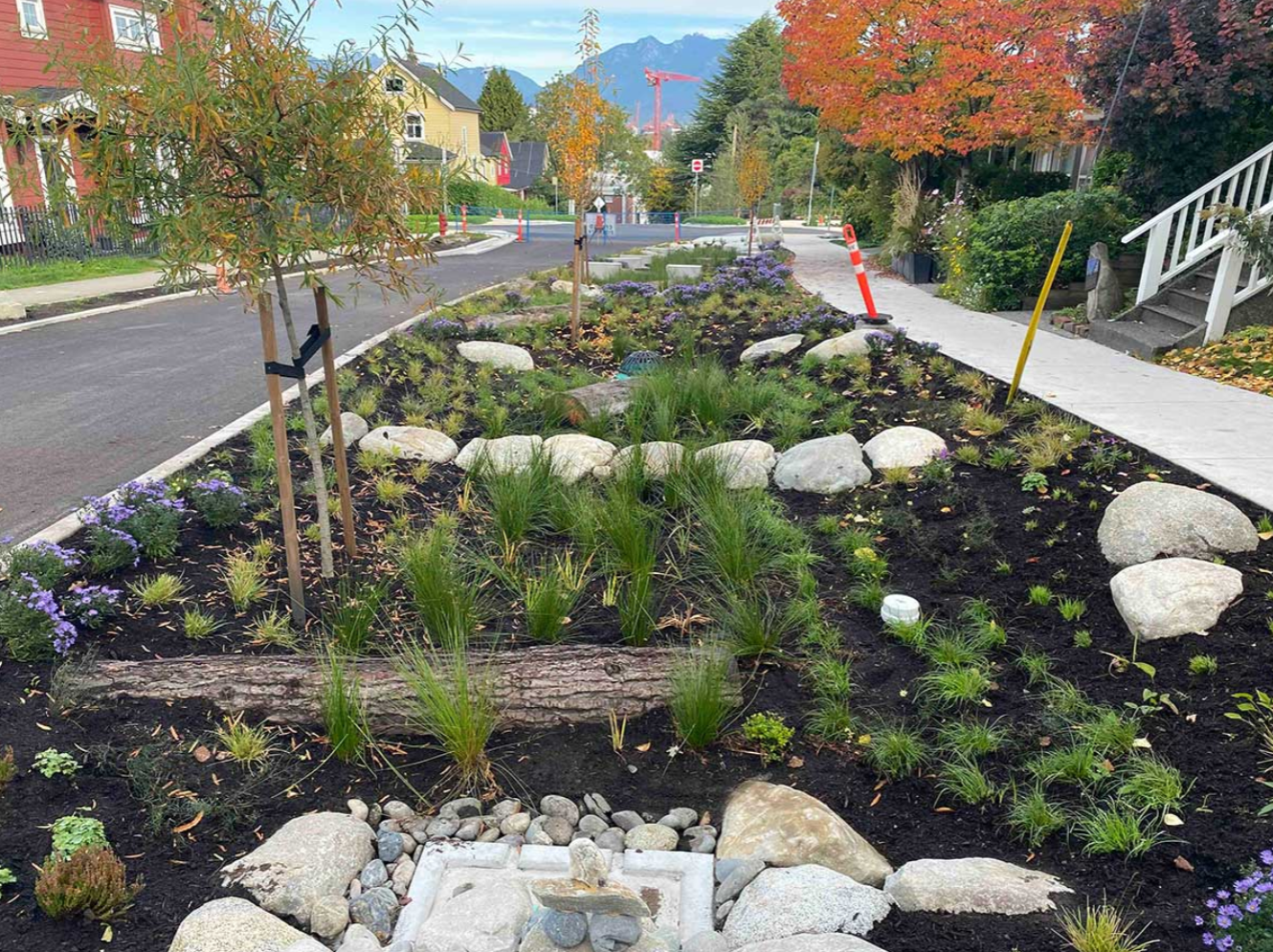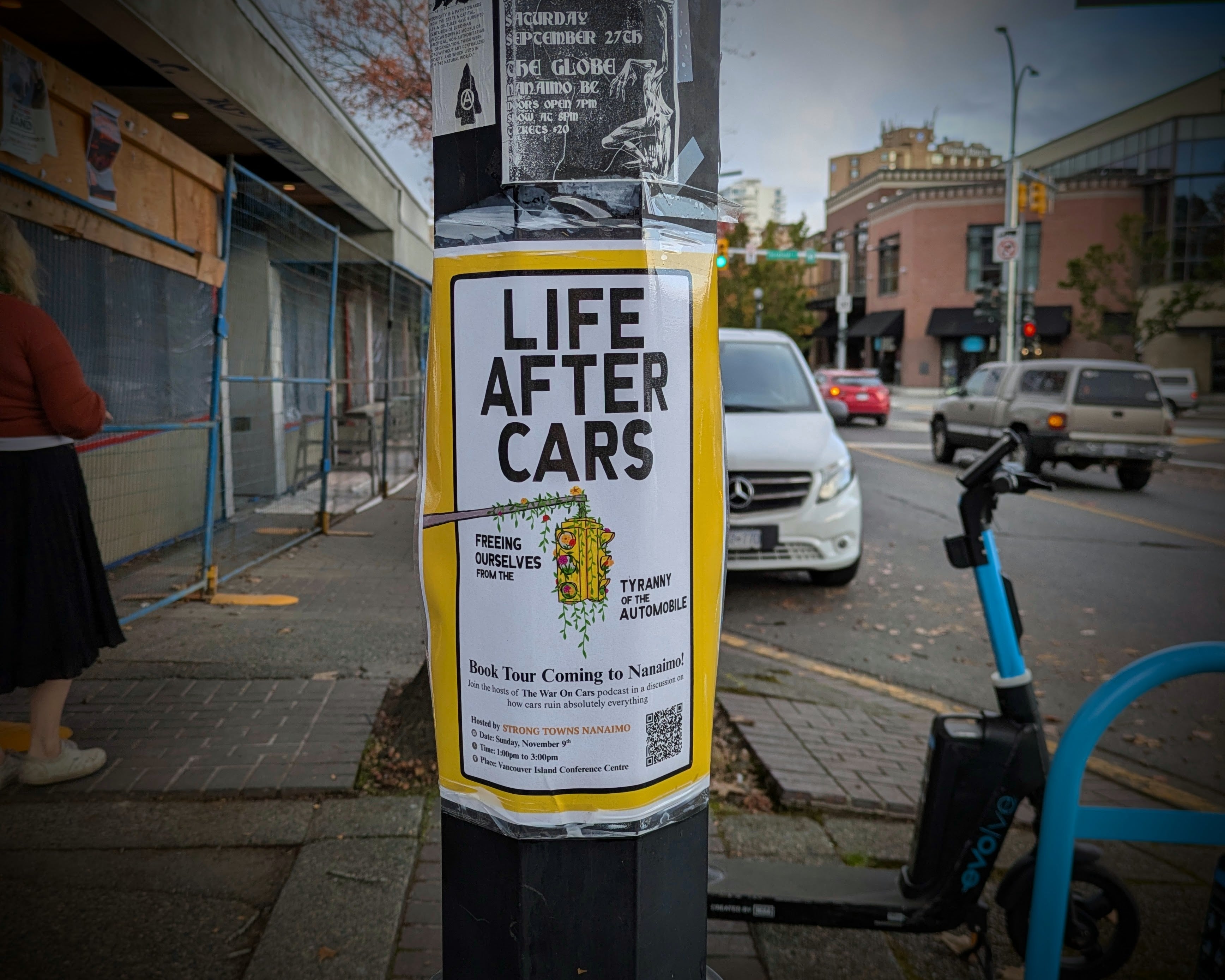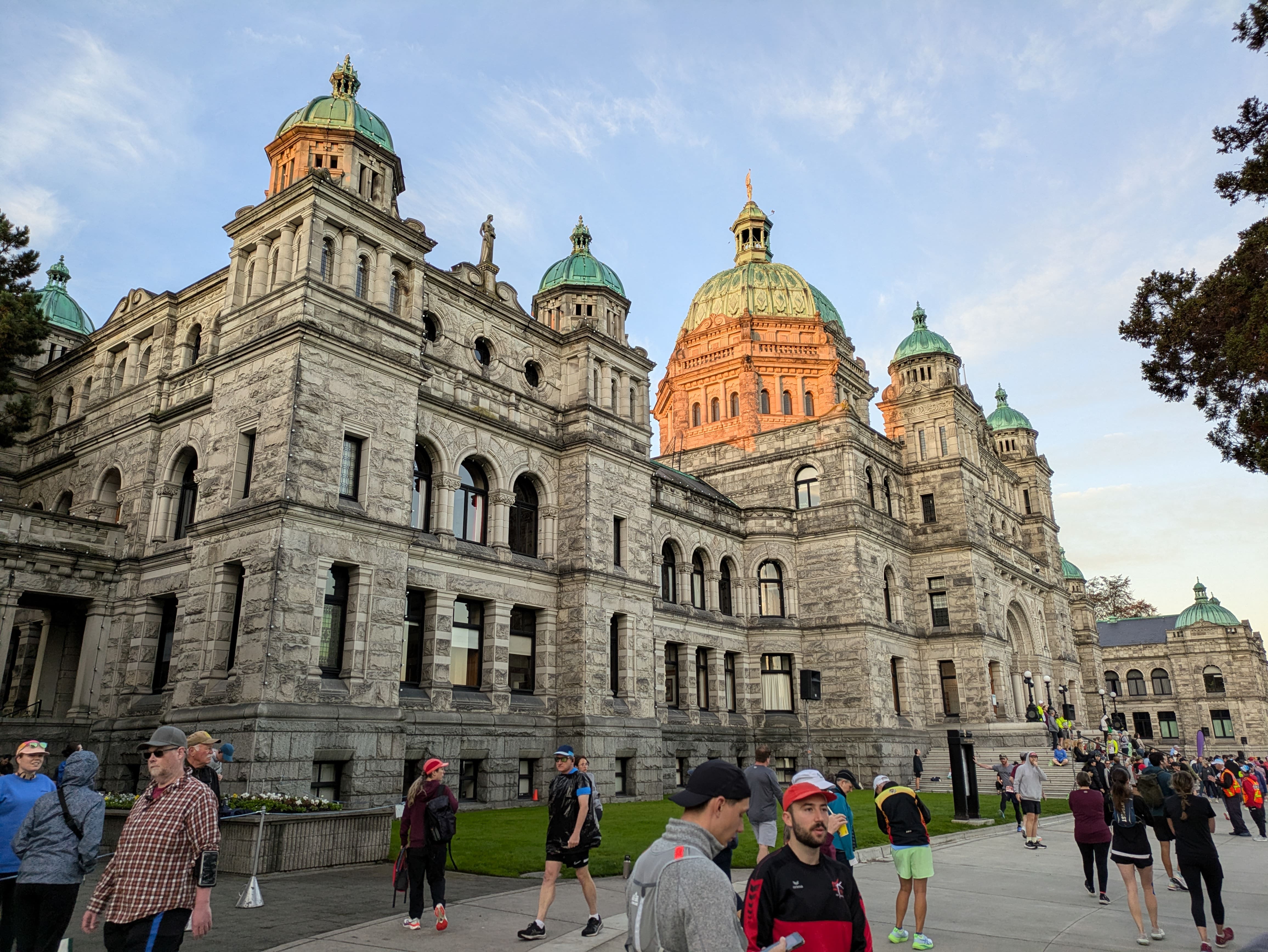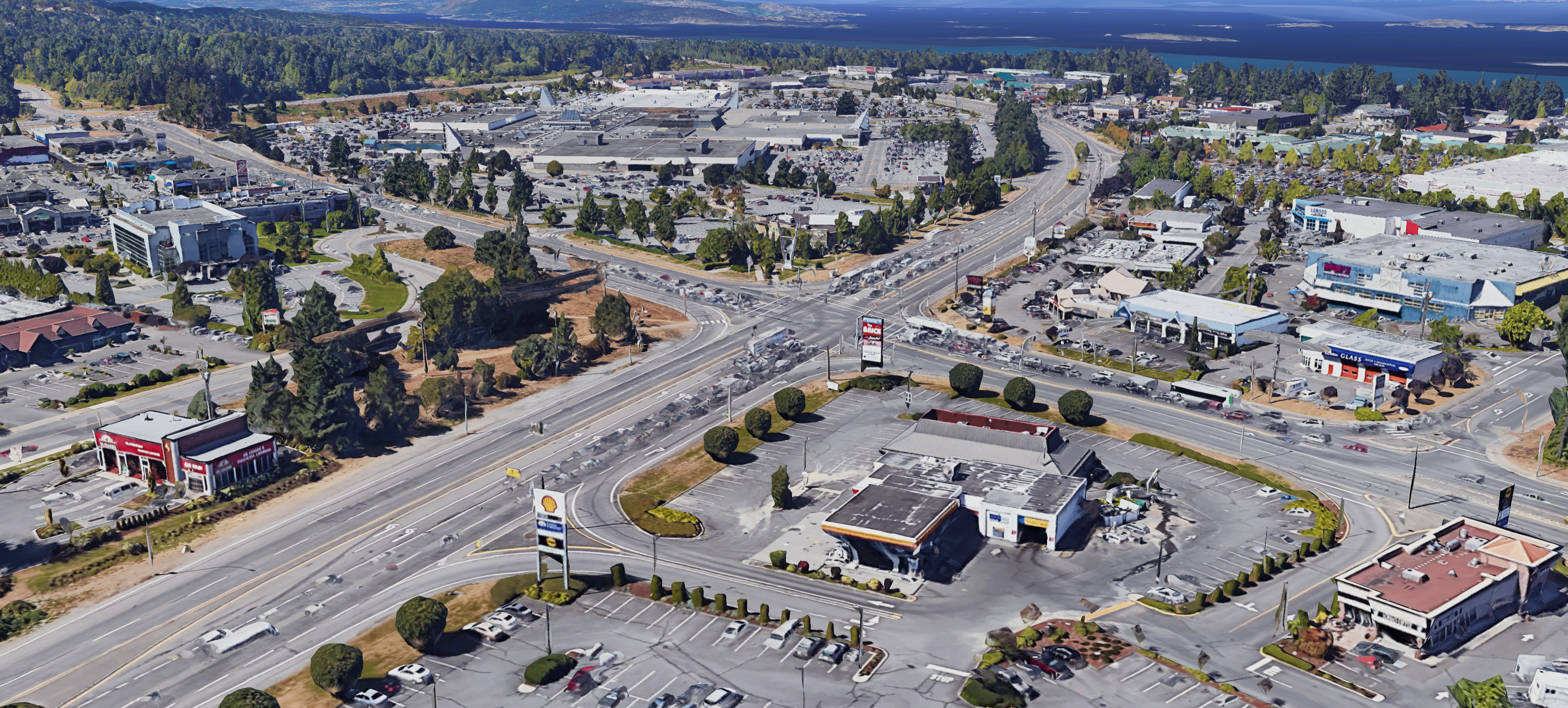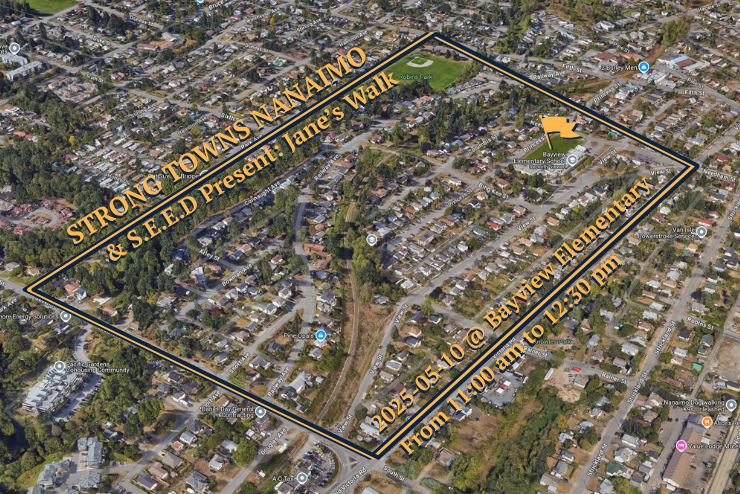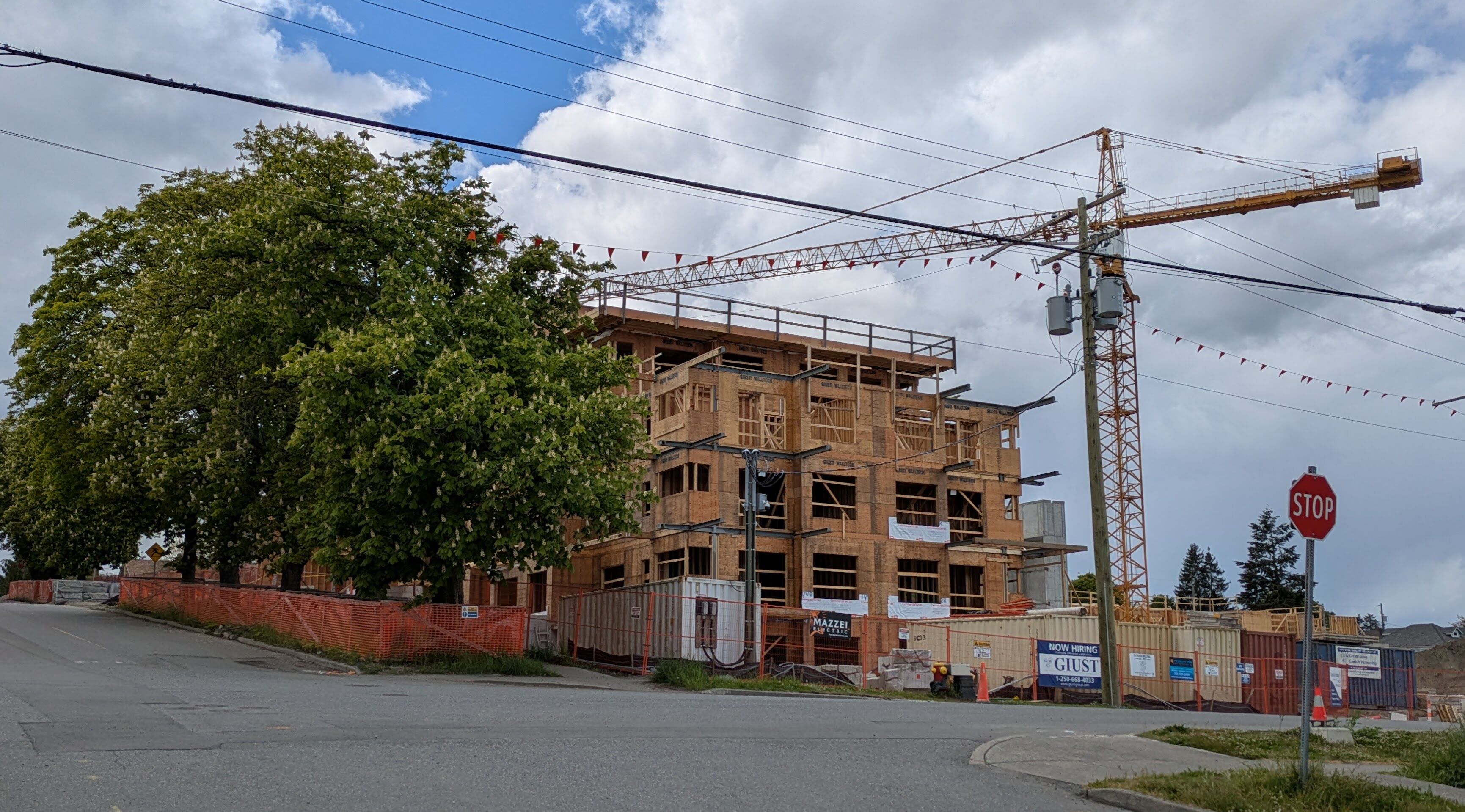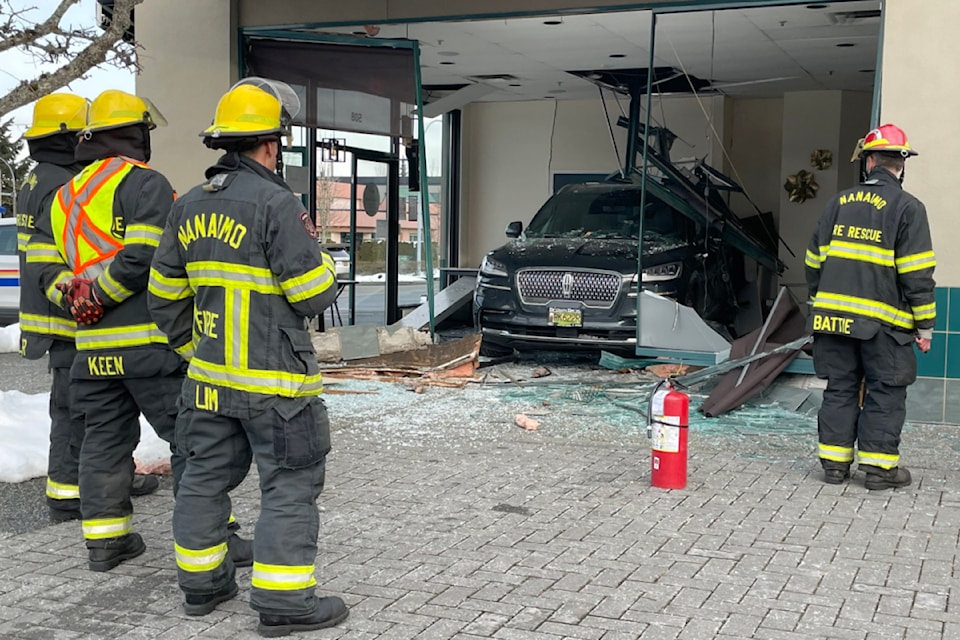Woodgrove, as it stands today, is a cautionary tale of suburban excess — a disconnected sprawl dominated by surface parking, fragmented land use, and a reliance on automobiles that stifles true community life. With the City of Nanaimo launching the Woodgrove Area Plan, we stand at a pivotal moment: either repeat the development mistakes of the past, or build a future rooted in the proven principles of vibrant, human-centered urbanism.
 The current roadway network for Woodgrove (left) and the current transit network for Woodgrove (right) shows how the highway and parking lots of Woodgrove Mall create a “moat” which separates the residential neighbourhoods to the East from the commercial and workplace destinations to the West.
The current roadway network for Woodgrove (left) and the current transit network for Woodgrove (right) shows how the highway and parking lots of Woodgrove Mall create a “moat” which separates the residential neighbourhoods to the East from the commercial and workplace destinations to the West.
Despite being one of Nanaimo’s busiest commercial hubs, Woodgrove is emblematic of failed 20th-century planning. Streetscapes are hostile to pedestrians, public transit access is limited, despite hosting a transit hub, and there is virtually no integration of housing, offices, or public spaces. It is, as Jane Jacobs warned in The Death and Life of Great American Cities, the predictable outcome when “streets and districts are built for cars, not for people.”
Today, Woodgrove’s commercial landscape is dominated by chain retailers, which account for 56.8% of all business licenses and a staggering 78.7% of the commercial floor area. Local retailers make up only 30.5% of licenses and occupy just 17.5% of space, leaving limited room for small, independent businesses that typically infuse vibrancy and resilience into local economies. Moreover, service commercial retailers — such as professional services (40%), financial institutions (21%), and health services (20%) — represent only 12% of the retail space, reflecting a limited diversity of uses. With a retail vacancy rate of 3.7%, which is lower than the healthy range (5–7%), it’s clear that while there is retail demand, the character of businesses fails to create the kind of lively, mixed-use urban environment needed for a true community hub.
Jeff Speck, author of Walkable City, would add that Woodgrove is textbook “car-first” design — leading directly to the congestion, environmental degradation, and economic leakage observed. His data shows that compact, walkable urban centers not only outperform sprawling developments economically but also foster greater community health and happiness.
The Baseline Assessment Report conducted by the City of Nanaimo codified the obvious: Woodgrove is overwhelmingly auto-oriented, with severe deficits in housing diversity, accessible parks, and transportation alternatives. This mismatch has compounded economic, environmental, and social costs.
Residents in the Woodgrove Urban Centre primarily rely on vehicle trips (85%) to access daily needs, followed by active modes of walking or cycling (10%) and transit (5%).
Urban visionary Jane Jacobs emphasized that “lively, diverse, intense cities contain the seeds of their own regeneration.” Woodgrove, by contrast, lacks the diversity of uses that generate natural surveillance, foot traffic, and community engagement. Jacobs would call Woodgrove an “unsuccessful district” — sterile, segmented, and ultimately unsustainable.
 Woodgrove’s transportation mode split (left) is predominantly auto-oriented, but when compared to the city-wide transporation mode split (right), it’s clear that the transit corridors around Woodgrove see increased ridership compared with the rest of town.
Woodgrove’s transportation mode split (left) is predominantly auto-oriented, but when compared to the city-wide transporation mode split (right), it’s clear that the transit corridors around Woodgrove see increased ridership compared with the rest of town.
Infrastructure in Woodgrove is at a breaking point. The sanitary sewer and water systems are both nearing capacity, meaning that significant upgrades will be necessary before meaningful new development can occur. The stormwater system, comprising a patchwork of City-owned and private infrastructure, is heavily burdened by the area’s 90% impervious surface coverage. Without proactive infrastructure investments, the vision for a higher-density, transit-oriented, mixed-use Woodgrove will be undermined by basic service limitations, threatening both the feasibility and livability of future growth.
 North Nanaimo’s municipal water system. Woodgrove is highlighted in the top-left of the image.
North Nanaimo’s municipal water system. Woodgrove is highlighted in the top-left of the image.
Jan Gehl, Danish architect and urban design expert, would critique Woodgrove for its complete disregard of life between buildings. His research shows that cities thrive when human-scale design prioritizes walking, cycling, and public life. In Woodgrove today, simple activities like strolling, socializing, or safely biking are almost impossible.
The vision for Woodgrove is to transform it into a complete community, yet its current form falls dramatically short. According to the assessment, while 100% of residential units are within walking distance of employment and daycare services, only 13% can walk to a grocery store and 0% can access parks, schools, or recreation facilities within an 800-meter distance. Even worse, access via cycling is significantly lower. Without major investments in parks, cultural spaces, mixed land uses, and multimodal infrastructure, Woodgrove will remain a sterile, car-dependent zone. A complete community, as envisioned by City Plan and funded through a $200,000 Complete Communities grant, demands not just higher residential density, but integration of daily needs, transportation options, housing diversity, and public spaces in close proximity.
 The Woodgrove Area’s walking & cycling routes map further showcases the region’s lack of permeability between neighbourhoods and uses. It’s challening to commute to work, school, or commercial destinations outside of a vehicle.
The Woodgrove Area’s walking & cycling routes map further showcases the region’s lack of permeability between neighbourhoods and uses. It’s challening to commute to work, school, or commercial destinations outside of a vehicle.
The Woodgrove Area Plan is not merely an exercise in technical planning. It is Nanaimo’s critical opportunity to correct historic patterns of failure by:
- Homes, jobs, daily needs, and recreation must coexist seamlessly.
- Walking, biking, and high-quality transit should be central, not secondary.
- Parks, plazas, and civic spaces need to be woven into the urban fabric to foster community.
- Infrastructure must support affordable housing, green space, and sustainable transportation to face future challenges.
To ignore these lessons would be to entrench the same dysfunctions that now plague our “Northern Gateway.”
The Woodgrove Area Plan can either perpetuate the lifeless, auto-dominated landscapes of the past — or it can catalyze a model for future-ready, people-centered development. If Nanaimo is serious about reimagining itself as a resilient, livable city, it must listen to the timeless warnings of Jacobs, Gehl, and Speck. We cannot afford another lost generation of bad planning.
There are many wonderful projects springing up throughout the Woodgrove area that signal that change is coming. The Met is a low-rise residential development that integrates well with the new active transportation infrastructure in place on Metral Drive. New developments on Calinda Street help fill in the residential community behind Applecross, improving the permeability of the space surrounding the public library off Hammond Bay. Embracing infill is a step in the right direction. With the Woodgrove Area Plan on the horizon, the City of Nanaimo has a chance to streamline similar developments in an effort to redefine this primarily auto-oriented area into a place where people are welcomed.
Woodgrove must not just be rebuilt. It must be reborn, project by project.
The following links, papers, articles, and talks informed this piece:
- 🔗 Woodgrove Area Plan - Get Involved Nanaimo
- 🔗 Woodgrove Area Baseline Assessment Report (March 2025)
- 📕 Walkable City By Jeff Speck
- 📕 The Death and Life of Great American Cities By Jane Jacobs
- 📕 Sprawl Repair Manual By Galina Tachieva
- 📃 Urban Sprawl: Diagnosis and Remedies By Jan K. Brueckner
- 📃 Urban Sprawl and Public Health By Howard Frumkin
